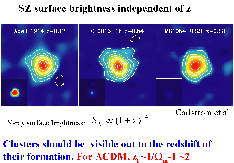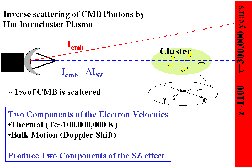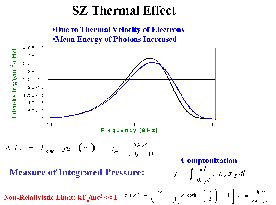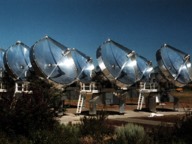Science
Structure Formation
Optical redshift surveys have shown that galaxies are not
distributed randomly in the universe, but are instead grouped
into clusters and voids as shown in the figure below.

The clustering of galaxies is the largest scale at which matter
is gravitationally bound in the universe, a galaxy cluster often
contains thousands of galaxies. Studies of galaxy clusters can
therefore act as a probe for studying the cosmological
parameters that determine the growth of structure in the
universe.
Clusters of galaxies are typically studied through optical
observations, X-ray observations, and in the last ten years,
Sunyaev-Zel'dovich (SZ) observations. However, most methods are
subject to a bias due to cosmological redshift.
In other words, the more distant clusters are more difficult to
detect. Only the SZ effect can be used to identify clusters of
galaxies independent of redshift. This property should allow an
SZ survey to identify galaxy clusters that are too distant to be
discovered in other surveys, producing a more complete catalog
of clusters.

SZ Effect
 The thermal SZ effect arises when low energy (2.73 K)
Cosmic Microwave Background (CMB) photons scatter off high
energy charged particles (100,000,000 K) in a galaxy cluster.
These charged particles were originally released when stars
started burning. A certain fraction of the starlight was
absorbed by neutral atoms, thereby releasing the electrons. The
free electrons and ionized nuclei fell into the gravitational
well of the neighborhood galaxy cluster and gained large amounts
of energy (several keV) in the process. This energy is
transferred from the hot intracluster plasma to the CMB photons
through inverse
Compton scattering. This process is referred to as the
thermal SZ effect. A similar process is the kinetic SZ effect
which arises from a Doppler shift of CMB photons that scatter
from the core of a cluster that is travelling with some velocity
with respect to the CMB. The signal of the kinetic SZ effect is
significantly smaller than that from the thermal SZ effect and
is yet to be observed.
The thermal SZ effect arises when low energy (2.73 K)
Cosmic Microwave Background (CMB) photons scatter off high
energy charged particles (100,000,000 K) in a galaxy cluster.
These charged particles were originally released when stars
started burning. A certain fraction of the starlight was
absorbed by neutral atoms, thereby releasing the electrons. The
free electrons and ionized nuclei fell into the gravitational
well of the neighborhood galaxy cluster and gained large amounts
of energy (several keV) in the process. This energy is
transferred from the hot intracluster plasma to the CMB photons
through inverse
Compton scattering. This process is referred to as the
thermal SZ effect. A similar process is the kinetic SZ effect
which arises from a Doppler shift of CMB photons that scatter
from the core of a cluster that is travelling with some velocity
with respect to the CMB. The signal of the kinetic SZ effect is
significantly smaller than that from the thermal SZ effect and
is yet to be observed.
 The average energy exchange in the scattering process is
kBTe/mec2, where
kB is Boltzmann's constant, Te is the
temperature of the cluster gas core, me is the mass
of the electron, and c is the speed of light. About one out of
every hundred CMB photons is scattered by the particles in the
cluster core. Since these photons typically gain energy in the
process, the result of the scattering is that the spectrum of
the CMB photons is distorted in the direction of a galaxy
cluster when observed from Earth (right). For more information
on the SZ effect and cosmology, look
here.
The average energy exchange in the scattering process is
kBTe/mec2, where
kB is Boltzmann's constant, Te is the
temperature of the cluster gas core, me is the mass
of the electron, and c is the speed of light. About one out of
every hundred CMB photons is scattered by the particles in the
cluster core. Since these photons typically gain energy in the
process, the result of the scattering is that the spectrum of
the CMB photons is distorted in the direction of a galaxy
cluster when observed from Earth (right). For more information
on the SZ effect and cosmology, look
here.
The SZ Power Spectrum
The evolution of galaxy clusters is a sensitive probe of
cosmology. Measurements of cluster masses and number density as
a function of redshift can be used to constrain the matter
density, ΩM of the universe, and the equation
of state of the cosmological
constant. Perhaps the most powerful use of the SZ effect
will be to probe the high redshift universe for clusters of
galaxies in a blind survey. Deep surveys that cover large areas
of sky will be sensitive to many high redshift clusters that
would not otherwise be observable. Correlating observations
from an SZ survey with optical observations will provide not
only cluster detections, but will hopefully also provide
redshift information which is essential for constraining these
cosmological parameters.
However, the available telescopes are not sensitive enough to
cover the field of view required to identify these large numbers
of galaxy clusters. Instead, it is possible to choose a smaller
region of sky and search for CMB anisotropy on the arcminute
angular scales that are matched to the size of a typical galaxy
cluster. From this sample, the data can be analyzed to estimate
an angular power spectrum. The angular power spectrum is a
measure of the signal that occurs as a function of angular
scale. A power spectrum analysis provides sensitivity to
objects that lie near the noise level of an image by comparing
the observed data to the signal that is expected from
instrumental noise. A low mass cluster of galaxies can still
contribute to the power spectrum by altering the overall
statistics of the data. We have used the BIMA array to estimate
the power spectrum on angular scales that are expected to be
dominated by the thermal SZ effect.
|




